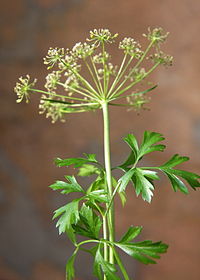
Photo from wikipedia
Caraway (Carum carvi L.) is a crop species with a gaining importance in Europe, especially as a condiment and medicinal plant. Here, we present the plant-pollinator network of caraway in… Click to show full abstract
Caraway (Carum carvi L.) is a crop species with a gaining importance in Europe, especially as a condiment and medicinal plant. Here, we present the plant-pollinator network of caraway in a central European agricultural landscape, focusing on two diverse potential pollinator taxa, Diptera: Brachycera (= true flies) and Hymenoptera (sawflies, bees, wasps, and ants). We specifically studied qualitative differences in interactions between the two insect taxa as well as the intraday and intraseasonal variability of the network. Insect and pollen plant species determination was done via morphological identification and DNA (meta)barcoding. In total, 121 species representing 33 families of Hymenoptera and Brachycera were found to carry caraway pollen. These taxa included many non-honeybee and non-hoverfly species, showing a wide taxonomic breadth of potential pollinators and a higher network complexity than previously anticipated. There are distinct qualitative differences between Brachycera and Hymenoptera networks, suggesting complementary roles of both taxa in the pollination of native and crop plants. Strong intraday differences in potential pollinator diversity make it necessary to collect insects and pollen at different times of the day to compile complete plant-pollinator networks. Intraseasonal analyses of the plant-pollinator network of caraway show the potential of caraway as an important food source for insect species with an activity peak in late summer.
Journal Title: Molecular ecology
Year Published: 2023
Link to full text (if available)
Share on Social Media: Sign Up to like & get
recommendations!